Test Article for BU Medicine Publication [For Code-Development]
In today’s fast-evolving educational landscape, digital classrooms represent a transformative shift.
- Technology continues to advance at a rapid pace, enhancing the educational experience.
- Institutions are increasingly adopting digital tools and platforms in multifaceted ways, which digital classrooms are revolutionizing.
In today’s fast-evolving educational landscape, digital classrooms represent a transformative shift in how students engage with learning materials and interact with educators. As technology continues to advance at a rapid pace, institutions are increasingly adopting digital tools and platforms to enhance the educational experience. This article explores the multifaceted ways in which digital classrooms are revolutionizing higher education, focusing on innovative technologies and their impact on teaching and learning.
This Content Not For Launch
Lorem ipsum dolor sit amet, consectetur adipiscing elit. Nulla vitae elit libero, a pharetra augue. Aenean eu leo quam. Pellentesque ornare sem lacinia quam venenatis vestibulum. Etiam porta sem malesuada magna mollis euismod.
Duis mollis, est non commodo luctus, nisi erat porttitor ligula, eget lacinia odio sem nec elit. Integer posuere erat a ante venenatis dapibus posuere velit aliquet. Nullam id dolor id nibh ultricies vehicula ut id elit. Vestibulum id ligula porta felis euismod semper.
Sed posuere consectetur est at lobortis. Maecenas faucibus mollis interdum. Vivamus sagittis lacus vel augue laoreet rutrum faucibus dolor auctor. Donec ullamcorper nulla non metus auctor fringilla. Morbi leo risus, porta ac consectetur ac, vestibulum at eros. Aenean lacinia bibendum nulla sed consectetur. Donec sed odio dui.
Lorem ipsum dolor sit amet, consectetur adipiscing elit. Lorem ipsum dolor sit amet, consectetur adipiscing elit. Fusce dapibus, tellus ac cursus commodo, tortor mauris condimentum nibh, ut fermentum massa justo sit amet risus. Donec ullamcorper nulla non metus auctor fringilla.
At the forefront of this revolution are immersive virtual classrooms, which provide students with an interactive and dynamic learning environment. These virtual spaces allow educators to deliver lectures, conduct discussions, and facilitate group activities in a manner that transcends physical limitations. Through the use of virtual reality (VR) and augmented reality (AR), students can explore complex concepts in a simulated environment, making abstract theories more tangible and engaging.
Moreover, the integration of artificial intelligence (AI) in digital classrooms is reshaping the educational landscape by personalizing learning experiences. AI-powered algorithms analyze students’ learning patterns and behaviors to deliver customized content and adaptive feedback. This not only caters to individual learning styles but also enhances student retention and engagement by addressing their unique academic needs.
Another pivotal aspect of digital classrooms is the proliferation of online collaboration tools and platforms. These tools enable seamless communication and collaboration among students and educators across geographical boundaries. Whether through virtual classrooms, discussion forums, or collaborative projects, students can actively participate in learning activities and benefit from diverse perspectives and expertise.
Furthermore, digital classrooms facilitate real-time access to a wealth of educational resources and multimedia content. From e-books and interactive simulations to online databases and virtual labs, students have unparalleled access to information that enriches their learning journey. This democratization of knowledge not only promotes self-directed learning but also empowers students to explore topics beyond traditional curriculum boundaries.
Donec sed odio dui. Praesent commodo cursus magna, vel scelerisque nisl consectetur et. Maecenas sed diam eget risus varius blandit sit amet non magna. Cras justo odio, dapibus ac facilisis in, egestas eget quam. Sed posuere consectetur est at lobortis.
Donec ullamcorper nulla non metus auctor fringilla. Vivamus sagittis lacus vel augue laoreet rutrum faucibus dolor auctor. Curabitur blandit tempus porttitor. Nullam id dolor id nibh ultricies vehicula ut id elit.
Nullam quis risus eget urna mollis ornare vel eu leo. Etiam porta sem malesuada magna mollis euismod. Vestibulum id ligula porta felis euismod semper. Maecenas sed diam eget risus varius blandit sit amet non magna. Aenean eu leo quam. Pellentesque ornare sem lacinia quam venenatis vestibulum. Lorem ipsum dolor sit amet, consectetur adipiscing elit.
Nulla vitae elit libero, a pharetra augue. Nullam id dolor id nibh ultricies vehicula ut id elit. Praesent commodo cursus magna, vel scelerisque nisl consectetur et. Donec ullamcorper nulla non metus auctor fringilla. Aenean eu leo quam. Pellentesque ornare sem lacinia quam venenatis vestibulum.
Donec ullamcorper nulla non metus auctor fringilla. Maecenas sed diam eget risus varius blandit sit amet non magna. Cras mattis consectetur purus sit amet fermentum. Sed posuere consectetur est at lobortis. Praesent commodo cursus magna, vel scelerisque nisl consectetur et.
Integer posuere erat a ante venenatis dapibus posuere velit aliquet. Fusce dapibus, tellus ac cursus commodo, tortor mauris condimentum nibh, ut fermentum massa justo sit amet risus. Sed posuere consectetur est at lobortis. Praesent commodo cursus magna, vel scelerisque nisl consectetur et. Lorem ipsum dolor sit amet, consectetur adipiscing elit.
 Be Sure to check image alignment for left and right. Vivamus sagittis lacus vel augue laoreet rutrum faucibus dolor auctor.
Be Sure to check image alignment for left and right. Vivamus sagittis lacus vel augue laoreet rutrum faucibus dolor auctor.Donec ullamcorper nulla non metus auctor fringilla. Maecenas sed diam eget risus varius blandit sit amet non magna. Cras mattis consectetur purus sit amet fermentum. Sed posuere consectetur est at lobortis. Praesent commodo cursus magna, vel scelerisque nisl consectetur et.
Duis mollis, est non commodo luctus, nisi erat porttitor ligula, eget lacinia odio sem nec elit. Integer posuere erat a ante venenatis dapibus posuere velit aliquet. Nulla vitae elit libero, a pharetra augue. Vestibulum id ligula porta felis euismod semper. Sed posuere consectetur est at lobortis. Nulla vitae elit libero, a pharetra augue. Fusce dapibus, tellus ac cursus commodo, tortor mauris condimentum nibh, ut fermentum massa justo sit amet risus.
Vivamus sagittis lacus vel augue laoreet rutrum faucibus dolor auctor. Aenean eu leo quam. Pellentesque ornare sem lacinia quam venenatis vestibulum. Sed posuere consectetur est at lobortis. Nullam id dolor id nibh ultricies vehicula ut id elit.
 Be Sure to check image alignment for left and right. Vivamus sagittis lacus vel augue laoreet rutrum faucibus dolor auctor.
Be Sure to check image alignment for left and right. Vivamus sagittis lacus vel augue laoreet rutrum faucibus dolor auctor.
Sed posuere consectetur est at lobortis. Vivamus sagittis lacus vel augue laoreet rutrum faucibus dolor auctor. Cras mattis consectetur purus sit amet fermentum. Duis mollis, est non commodo luctus, nisi erat porttitor ligula, eget lacinia odio sem nec elit. Etiam porta sem malesuada magna mollis euismod. Donec id elit non mi porta gravida at eget metus. Duis mollis, est non commodo luctus, nisi erat porttitor ligula, eget lacinia odio sem nec elit.
Donec sed odio dui. Praesent commodo cursus magna, vel scelerisque nisl consectetur et. Maecenas sed diam eget risus varius blandit sit amet non magna. Cras justo odio, dapibus ac facilisis in, egestas eget quam. Sed posuere consectetur est at lobortis.
 Be Sure to check image alignment for left and right. Vivamus sagittis lacus vel augue laoreet rutrum faucibus dolor auctor.
Be Sure to check image alignment for left and right. Vivamus sagittis lacus vel augue laoreet rutrum faucibus dolor auctor.Cum sociis natoque penatibus et magnis dis parturient montes, nascetur ridiculus mus. Sed posuere consectetur est at lobortis. Nulla vitae elit libero, a pharetra augue. Cum sociis natoque penatibus et magnis dis parturient montes, nascetur ridiculus mus. Curabitur blandit tempus porttitor. Cum sociis natoque penatibus et magnis dis parturient montes, nascetur ridiculus mus.
Donec sed odio dui. Vivamus sagittis lacus vel augue laoreet rutrum faucibus dolor auctor. Lorem ipsum dolor sit amet, consectetur adipiscing elit. Cras mattis consectetur purus sit amet fermentum.
Duis mollis, est non commodo luctus, nisi erat porttitor ligula, eget lacinia odio sem nec elit. Integer posuere erat a ante venenatis dapibus posuere velit aliquet. Nulla vitae elit libero, a pharetra augue. Vestibulum id ligula porta felis euismod semper. Sed posuere consectetur est at lobortis. Nulla vitae elit libero, a pharetra augue. Fusce dapibus, tellus ac cursus commodo, tortor mauris condimentum nibh, ut fermentum massa justo sit amet risus.
Integer posuere erat a ante venenatis dapibus posuere velit aliquet. Fusce dapibus, tellus ac cursus commodo, tortor mauris condimentum nibh, ut fermentum massa justo sit amet risus. Sed posuere consectetur est at lobortis. Praesent commodo cursus magna, vel scelerisque nisl consectetur et. Lorem ipsum dolor sit amet, consectetur adipiscing elit.
Donec ullamcorper nulla non metus auctor fringilla. Praesent commodo cursus magna, vel scelerisque nisl consectetur et. Praesent commodo cursus magna, vel scelerisque nisl consectetur et. Cras mattis consectetur purus sit amet fermentum. Donec sed odio dui. Donec id elit non mi porta gravida at eget metus.
Nulla vitae elit libero, a pharetra augue. Cum sociis natoque risus eget ipsum dolor sit amet, consectetur parturient montes, nascetur ridiculus mus. Cum sociis natoque penatibus et magnis dis parturient montes, nascetur ridiculus mus. Maecenas sed diam eget risus varius blandit sit amet non magna.
Vestibulum id ligula porta felis euismod semper. Aenean eu leo quam. Pellentesque ornare sem lacinia quam venenatis vestibulum. Aenean lacinia bibendum nulla sed consectetur. Etiam porta sem malesuada magna mollis euismod. Donec sed odio dui. Lorem ipsum dolor sit amet, consectetur adipiscing elit.
Cras justo odio, dapibus ac facilisis in, egestas eget quam. Fusce dapibus, tellus ac cursus commodo, tortor mauris condimentum nibh, ut fermentum massa justo sit amet risus. Vestibulum id ligula porta felis euismod semper. Aenean eu leo quam. Pellentesque ornare sem lacinia quam venenatis vestibulum. Donec ullamcorper nulla non metus auctor fringilla. Integer posuere erat a ante venenatis dapibus posuere velit aliquet.
Preformatted Text Nullam quis risus eget urna mollis ornare vel eu leo.
#header h1 a {
display: block;
width: 300px;
height: 80px;
}
October 2025
| M |
T |
W |
T |
F |
S |
S |
| | 1 | 2 | 3 | 4 | 5 |
| 6 | 7 | 8 | 9 | 10 | 11 | 12 |
| 13 | 14 | 15 | 16 | 17 | 18 | 19 |
| 20 | 21 | 22 | 23 | 24 | 25 | 26 |
| 27 | 28 | 29 | 30 | 31 |
|
Unordered List
- Morbi in sem quis dui placerat ornare. Pellentesque odio nisi, euismod in, pharetra a, ultricies in, diam. Sed arcu. Cras consequat.Sub-item
- Tellus Ultricies Euismod Sem
- Cum sociis natoque penatibus et magnis dis parturient montes, nascetur ridiculus mus.
- Nullam id dolor id nibh ultricies vehicula ut id elit.
- Donec ullamcorper nulla non metus auctor fringilla.
- Praesent dapibus, neque id cursus faucibus, tortor neque egestas augue, eu vulputate magna eros eu erat. Aliquam erat volutpat. Nam dui mi, tincidunt quis, accumsan porttitor, facilisis luctus, metus.
- Phasellus ultrices nulla quis nibh. Quisque a lectus. Donec consectetuer ligula vulputate sem tristique cursus. Nam nulla quam, gravida non, commodo a, sodales sit amet, nisi.
- Pellentesque fermentum dolor. Aliquam quam lectus, facilisis auctor, ultrices ut, elementum vulputate, nunc.
Ordered List
- Lorem ipsum dolor sit amet, consectetuer adipiscing elit.
- Vestibulum auctor dapibus neque.
- Fringilla Malesuada Sit Parturient
- Sed posuere consectetur est at lobortis. Maecenas faucibus mollis interdum. Lorem ipsum dolor sit amet, consectetur adipiscing elit.
- Etiam porta sem malesuada magna mollis euismod. Lorem ipsum dolor sit amet, consectetur adipiscing elit.
- Vestibulum auctor dapibus neque.
- Duis mollis, est non commodo luctus, nisi erat porttitor ligula, eget lacinia odio sem nec elit. Aenean eu leo quam. Pellentesque ornare sem lacinia quam venenatis vestibulum. Nullam quis risus eget urna mollis ornare vel eu leo.
- Aliquam tincidunt Vestibulum id ligula porta felis euismod semper. Nulla vitae elit libero, a pharetra augue. Aenean lacinia bibendum nulla sed consectetur. Sed posuere consectetur est at lobortis.
- Vestibulum auctor dapibus neque.
Table (Standard)
| Season | Fall | Winter | Spring | Summer |
| Description | Also known as autumn, fall in New England is famous for the landscape of bright reds, oranges, and yellows as the leaves change color. | Often brings very cold temperatures and snowstorms. | Weather becomes milder towards April; days become longer and flowers bloom. Frequent rainfall and strong winds are common. | Often very hot and humid, especially in the middle of the season. |
| Apparel | Light jackets, scarves, sweaters; switching to hats and heavier jackets later in the season. | Heavy coats, all-weather boots, scarves, gloves, and hats. | Coats, sweaters, hats, and scarves early in the season, lighter apparel and rain gear as temperatures warm up | Lightweight clothing and sun protection |
| Months | mid-Sept.–late Nov. | Dec.–late March | late March–mid June | mid-June–mid-Sept. |
| Average Temp. | 46–60° F/
8–15° C | 0–37° F/
-17–3° C | 38–60° F/
3–15° C | 60–95° F/
15–35° C |
Table (Standard) w/ Caption
| Season | Fall | Winter | Spring | Summer |
| Description | Also known as autumn, fall in New England is famous for the landscape of bright reds, oranges, and yellows as the leaves change color. | Often brings very cold temperatures and snowstorms. | Weather becomes milder towards April; days become longer and flowers bloom. Frequent rainfall and strong winds are common. | Often very hot and humid, especially in the middle of the season. |
| Apparel | Light jackets, scarves, sweaters; switching to hats and heavier jackets later in the season. | Heavy coats, all-weather boots, scarves, gloves, and hats. | Coats, sweaters, hats, and scarves early in the season, lighter apparel and rain gear as temperatures warm up | Lightweight clothing and sun protection |
| Months | mid-Sept.–late Nov. | Dec.–late March | late March–mid June | mid-June–mid-Sept. |
| Average Temp. | 46–60° F/
8–15° C | 0–37° F/
-17–3° C | 38–60° F/
3–15° C | 60–95° F/
15–35° C |
Nullam quis risus eget ipsum dolor sit amet, consectetur vel eu leo. Lorem ipsum dolor sit amet, consectetur adipiscing elit.Table w/ Heading
| Season | Fall | Winter | Spring | Summer |
|---|
| Description | Also known as autumn, fall in New England is famous for the landscape of bright reds, oranges, and yellows as the leaves change color. | Often brings very cold temperatures and snowstorms. | Weather becomes milder towards April; days become longer and flowers bloom. Frequent rainfall and strong winds are common. | Often very hot and humid, especially in the middle of the season. |
| Apparel | Light jackets, scarves, sweaters; switching to hats and heavier jackets later in the season. | Heavy coats, all-weather boots, scarves, gloves, and hats. | Coats, sweaters, hats, and scarves early in the season, lighter apparel and rain gear as temperatures warm up | Lightweight clothing and sun protection |
| Months | mid-Sept.–late Nov. | Dec.–late March | late March–mid June | mid-June–mid-Sept. |
| Average Temp. | 46–60° F/
8–15° C | 0–37° F/
-17–3° C | 38–60° F/
3–15° C | 60–95° F/
15–35° C |
Table w/ Header & Footer Section
| Season | Fall | Winter | Spring | Summer |
|---|
| Description | Also known as autumn, fall in New England is famous for the landscape of bright reds, oranges, and yellows as the leaves change color. | Often brings very cold temperatures and snowstorms. | Weather becomes milder towards April; days become longer and flowers bloom. Frequent rainfall and strong winds are common. | Often very hot and humid, especially in the middle of the season. |
| Apparel | Light jackets, scarves, sweaters; switching to hats and heavier jackets later in the season. | Heavy coats, all-weather boots, scarves, gloves, and hats. | Coats, sweaters, hats, and scarves early in the season, lighter apparel and rain gear as temperatures warm up | Lightweight clothing and sun protection |
| Months | mid-Sept.–late Nov. | Dec.–late March | late March–mid June | mid-June–mid-Sept. |
| Average Temp. | 46–60° F/
8–15° C | 0–37° F/
-17–3° C | 38–60° F/
3–15° C | 60–95° F/
15–35° C |
| | | | |
BU Stats
Stats (No Theme Override)
Stats (Default Theme Override)
Stats (Dark Theme Override)
Cum sociis natoque penatibus et magnis dis parturient montes, nascetur ridiculus mus. Praesent commodo cursus magna, vel scelerisque nisl consectetur et. Fusce dapibus, tellus ac cursus commodo, tortor mauris condimentum nibh, ut fermentum massa justo sit amet risus.
Fermentum Mollis
Cum sociis natoque penatibus et magnis dis parturient montes, nascetur ridiculus mus. Praesent commodo cursus magna, vel scelerisque nisl consectetur et. Fusce dapibus, tellus ac cursus commodo, tortor mauris condimentum nibh, ut fermentum massa justo sit amet risus.
Fermentum Mollis
Ut wisi enim ad minim veniam, quis nostrud exerci tation ullamcorper suscipit lobortis nisl ut aliquip ex ea commodo consequat. Duis autem vel eum iriure dolor in hendrerit in vulputate velit esse molestie consequat, vel illum dolore eu feugiat nulla facilisis at vero eros et accumsan et iusto odio dignissim qui blandit praesent luptatum zzril delenit augue duis dolore te feugait nulla facilisi.
Ut wisi enim ad minim veniam, quis nostrud exerci tation ullamcorper suscipit lobortis nisl ut aliquip ex ea commodo consequat. Duis autem vel eum iriure dolor in hendrerit in vulputate velit esse molestie consequat, vel illum dolore eu feugiat nulla facilisis at vero eros et accumsan et iusto odio dignissim qui blandit praesent luptatum zzril delenit augue duis dolore te feugait nulla facilisi.
Ut wisi enim ad minim veniam, quis nostrud exerci tation ullamcorper suscipit lobortis nisl ut aliquip ex ea commodo consequat. Duis autem vel eum iriure dolor in hendrerit in vulputate velit esse molestie consequat, vel illum dolore eu feugiat nulla facilisis at vero eros et accumsan et iusto odio dignissim qui blandit praesent luptatum zzril delenit augue duis dolore te feugait nulla facilisi.
Ut wisi enim ad minim veniam, quis nostrud exerci tation ullamcorper suscipit lobortis nisl ut aliquip ex ea commodo consequat. Duis autem vel eum iriure dolor in hendrerit in vulputate velit esse molestie consequat, vel illum dolore eu feugiat nulla facilisis at vero eros et accumsan et iusto odio dignissim qui blandit praesent luptatum zzril delenit augue duis dolore te feugait nulla facilisi.
Ut wisi enim ad minim veniam, quis nostrud exerci tation ullamcorper suscipit lobortis nisl ut aliquip ex ea commodo consequat. Duis autem vel eum iriure dolor in hendrerit in vulputate velit esse molestie consequat, vel illum dolore eu feugiat nulla facilisis at vero eros et accumsan et iusto odio dignissim qui blandit praesent luptatum zzril delenit augue duis dolore te feugait nulla facilisi.
 Dean Antman delivers remarks at the school’s naming celebration dinner in September 2022.
Dean Antman delivers remarks at the school’s naming celebration dinner in September 2022.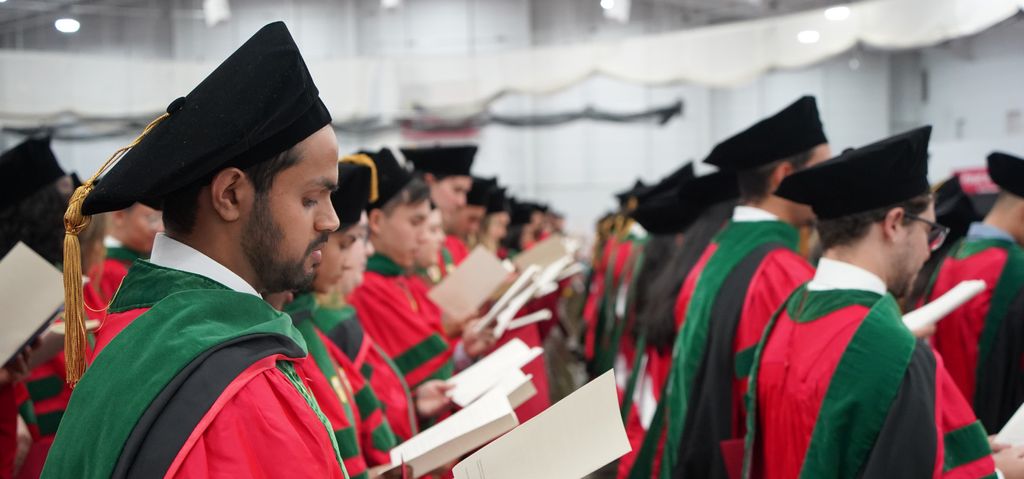 MD graduates recite the Hippocratic Oath signaling their entrance into the practice of medicine.
MD graduates recite the Hippocratic Oath signaling their entrance into the practice of medicine.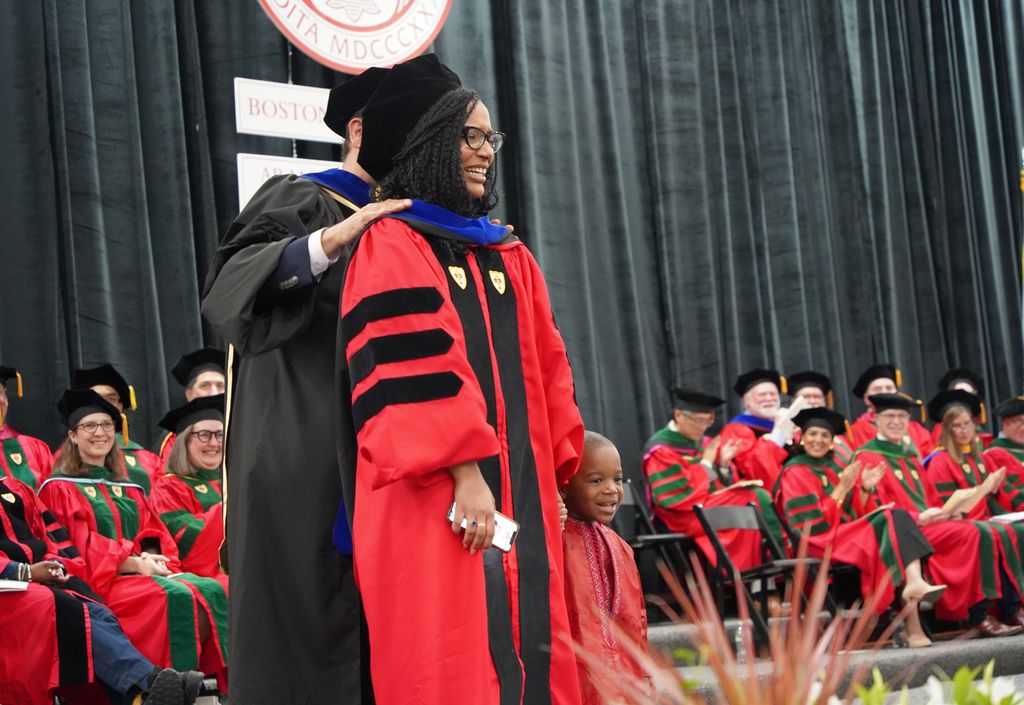 PhD student speaker Josiane Fofana shared the special moment with her 3-year-old child.
PhD student speaker Josiane Fofana shared the special moment with her 3-year-old child.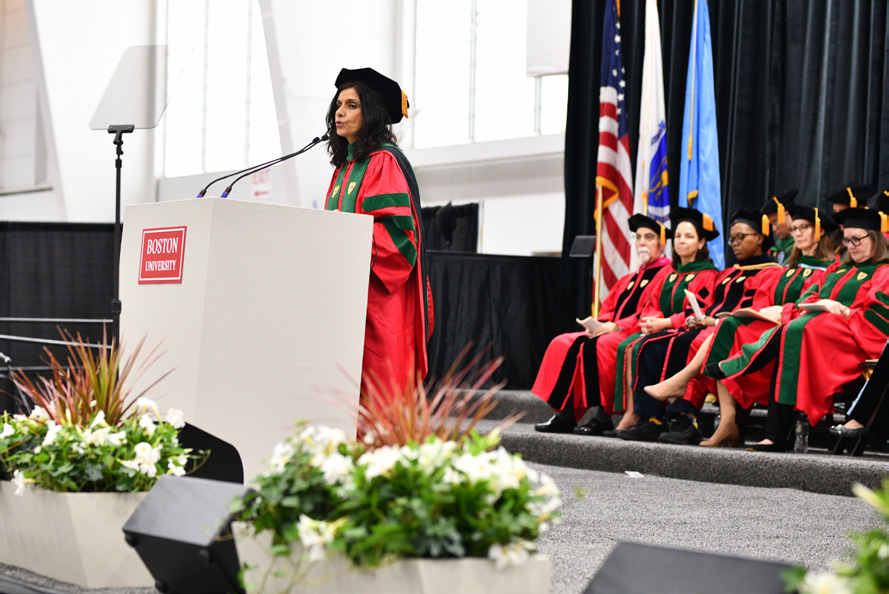 Convocation speaker Monica Bharel, MD (CAMED’94), MPH, the clinical lead for public sector health at Google, told students, “Healthcare is a basic human right, not a privilege.”
Convocation speaker Monica Bharel, MD (CAMED’94), MPH, the clinical lead for public sector health at Google, told students, “Healthcare is a basic human right, not a privilege.” Master’s degree candidates line up before the ceremony.
Master’s degree candidates line up before the ceremony.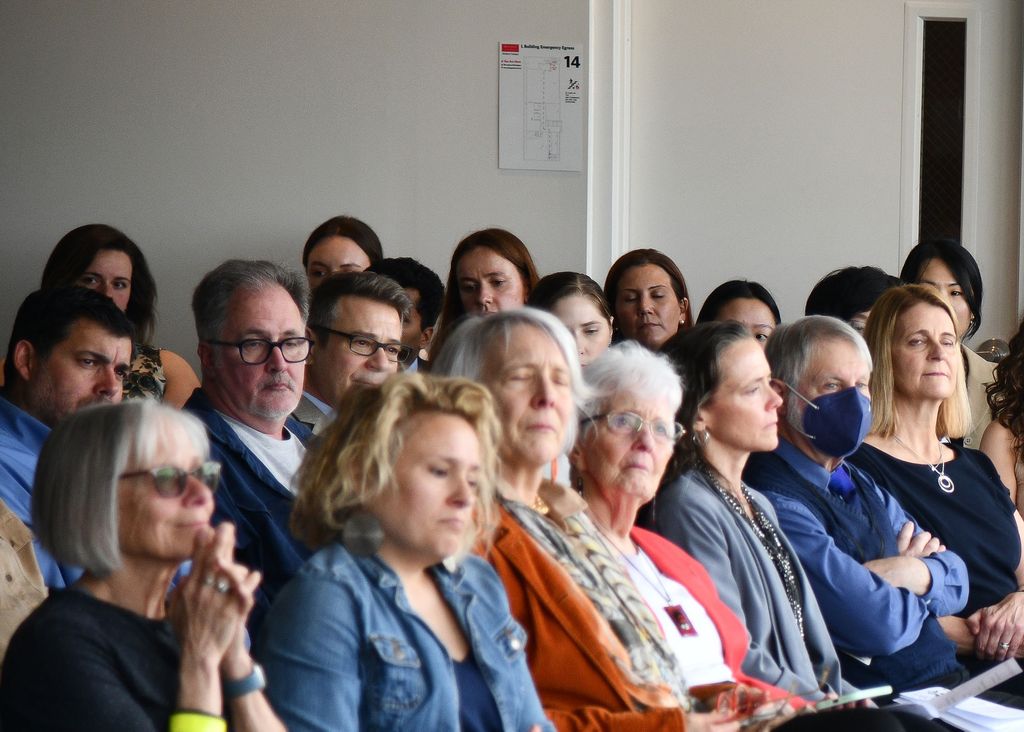 Medical students spoke at the donor memorial service.
Medical students spoke at the donor memorial service. Second-year med student Jackson Wallner talks with retired Army drill sergeant Robert “Rick” Jones.
Second-year med student Jackson Wallner talks with retired Army drill sergeant Robert “Rick” Jones.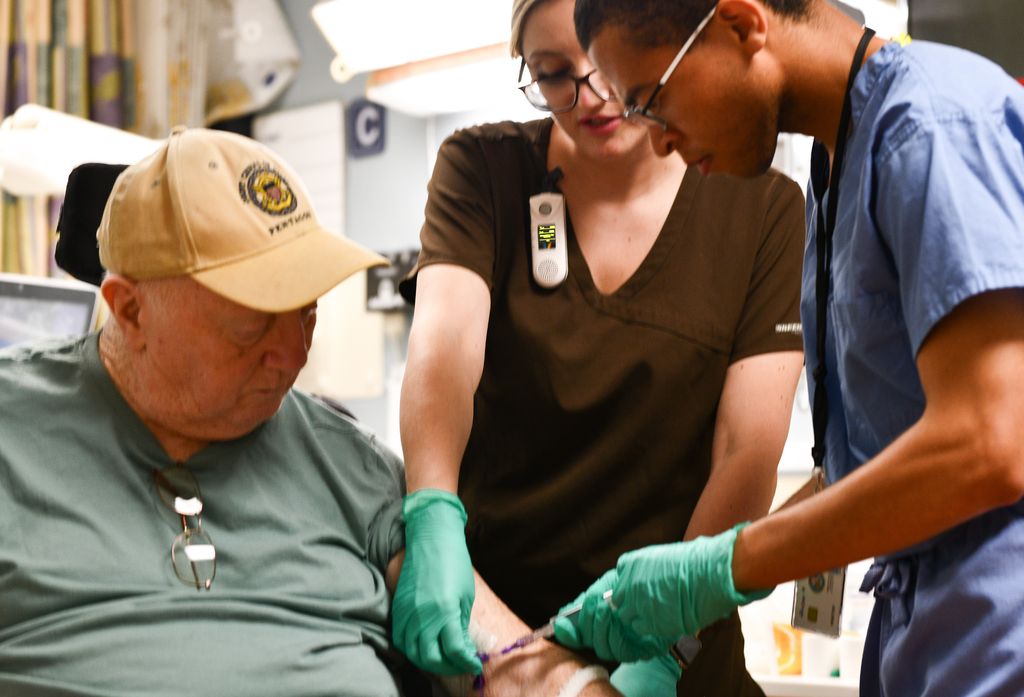 Second-year med student Douglass Bryant, working under supervision of vascular access nurse Kassidy Dias, RN, flushes an IV line of Army veteran Robert McAllister.
Second-year med student Douglass Bryant, working under supervision of vascular access nurse Kassidy Dias, RN, flushes an IV line of Army veteran Robert McAllister.
 Dean Antman delivers remarks at the school’s naming celebration dinner in September 2022.
Dean Antman delivers remarks at the school’s naming celebration dinner in September 2022. MD graduates recite the Hippocratic Oath signaling their entrance into the practice of medicine.
MD graduates recite the Hippocratic Oath signaling their entrance into the practice of medicine. PhD student speaker Josiane Fofana shared the special moment with her 3-year-old child.
PhD student speaker Josiane Fofana shared the special moment with her 3-year-old child. Convocation speaker Monica Bharel, MD (CAMED’94), MPH, the clinical lead for public sector health at Google, told students, “Healthcare is a basic human right, not a privilege.”
Convocation speaker Monica Bharel, MD (CAMED’94), MPH, the clinical lead for public sector health at Google, told students, “Healthcare is a basic human right, not a privilege.” Master’s degree candidates line up before the ceremony.
Master’s degree candidates line up before the ceremony. Medical students spoke at the donor memorial service.
Medical students spoke at the donor memorial service. Second-year med student Jackson Wallner talks with retired Army drill sergeant Robert “Rick” Jones.
Second-year med student Jackson Wallner talks with retired Army drill sergeant Robert “Rick” Jones. Second-year med student Douglass Bryant, working under supervision of vascular access nurse Kassidy Dias, RN, flushes an IV line of Army veteran Robert McAllister.
Second-year med student Douglass Bryant, working under supervision of vascular access nurse Kassidy Dias, RN, flushes an IV line of Army veteran Robert McAllister.
 Dean Antman delivers remarks at the school’s naming celebration dinner in September 2022.
Dean Antman delivers remarks at the school’s naming celebration dinner in September 2022. MD graduates recite the Hippocratic Oath signaling their entrance into the practice of medicine.
MD graduates recite the Hippocratic Oath signaling their entrance into the practice of medicine. PhD student speaker Josiane Fofana shared the special moment with her 3-year-old child.
PhD student speaker Josiane Fofana shared the special moment with her 3-year-old child. Convocation speaker Monica Bharel, MD (CAMED’94), MPH, the clinical lead for public sector health at Google, told students, “Healthcare is a basic human right, not a privilege.”
Convocation speaker Monica Bharel, MD (CAMED’94), MPH, the clinical lead for public sector health at Google, told students, “Healthcare is a basic human right, not a privilege.” Master’s degree candidates line up before the ceremony.
Master’s degree candidates line up before the ceremony. Medical students spoke at the donor memorial service.
Medical students spoke at the donor memorial service. Second-year med student Jackson Wallner talks with retired Army drill sergeant Robert “Rick” Jones.
Second-year med student Jackson Wallner talks with retired Army drill sergeant Robert “Rick” Jones. Second-year med student Douglass Bryant, working under supervision of vascular access nurse Kassidy Dias, RN, flushes an IV line of Army veteran Robert McAllister.
Second-year med student Douglass Bryant, working under supervision of vascular access nurse Kassidy Dias, RN, flushes an IV line of Army veteran Robert McAllister.
Nullam quis risus eget urna mollis ornare vel eu leo. Lorem ipsum dolor sit amet, consectetur adipiscing elit.
Nullam quis risus eget ipsum dolor sit amet, consectetur vel eu leo. Lorem ipsum dolor sit amet, consectetur adipiscing elit.
Virtual reality (VR) technology is revolutionizing the educational landscape, offering unprecedented opportunities for immersive learning experiences that enhance student engagement and learning outcomes. As higher education institutions strive to incorporate cutting-edge technologies into their pedagogical practices, VR stands out as a powerful tool that can transform traditional learning environments.
At the heart of VR’s appeal is its ability to create highly immersive, interactive environments where students can engage with content in ways that were previously unimaginable. Unlike conventional learning methods that rely heavily on textbooks and lectures, VR enables students to step inside virtual worlds where they can explore, interact, and experiment. This level of immersion fosters deeper understanding and retention of complex concepts.
VR enables students to step inside virtual worlds where they can explore, interact, and experiment.
VR enables students to step inside virtual worlds where they can explore, interact, and experiment.
VR enables students to step inside virtual worlds where they can explore, interact, and experiment.
One of the most significant impacts of VR in higher education is its ability to make abstract or difficult-to-visualize subjects more tangible. For instance, in disciplines like medicine and engineering, VR can simulate real-world scenarios that allow students to practice and hone their skills in a safe, controlled environment. Medical students can perform virtual surgeries, gaining hands-on experience without the risks associated with real-life procedures. Engineering students can construct and test virtual models, observing the effects of different variables in real-time.
Moreover, VR technology is democratizing education by providing access to experiences that may be geographically or financially inaccessible. Students can embark on virtual field trips to historical sites, laboratories, and even outer space, all from the comfort of their classrooms. This accessibility broadens their horizons and enriches their educational journey, making learning more inclusive and equitable.
VR technology is democratizing education by providing access to experiences that may be geographically or financially inaccessible
— Steve Gates
VR technology is democratizing education by providing access to experiences that may be geographically or financially inaccessible
— Steve Gates
VR technology is democratizing education by providing access to experiences that may be geographically or financially inaccessible
Steve Gates
VR technology is democratizing education by providing access to experiences that may be geographically or financially inaccessible
— Steve Gates
VR technology is democratizing education by providing access to experiences that may be geographically or financially inaccessible
— Steve Gates
VR technology is democratizing education by providing access to experiences that may be geographically or financially inaccessible
— Steve Gates
The interactive nature of VR also promotes active learning, a pedagogical approach that encourages students to engage directly with the material, collaborate with peers, and apply their knowledge in practical settings. This active engagement is linked to improved critical thinking and problem-solving skills. For example, in a virtual biology lab, students can conduct experiments, manipulate variables, and observe outcomes, leading to a more profound and practical understanding of scientific principles.
Furthermore, VR is proving to be a valuable tool in enhancing student motivation and reducing disengagement. The novelty and excitement of VR experiences capture students’ attention and sustain their interest over time. Educators are reporting higher levels of student participation and enthusiasm in courses that integrate VR technology, leading to better academic performance and satisfaction.
However, the integration of VR in higher education is not without challenges. Institutions must invest in the necessary infrastructure, including VR headsets and compatible software, which can be costly. Additionally, there is a learning curve for both instructors and students in adapting to this new mode of learning. Educators need to develop VR-specific curricula and teaching strategies to fully leverage the potential of this technology.
Despite these challenges, the benefits of VR in higher education are becoming increasingly evident. As more institutions embrace this innovative tool, we are likely to see a shift towards more immersive, interactive, and engaging learning experiences. The potential of VR to transform education is vast, promising to create a more dynamic and effective learning environment that prepares students for the complexities of the modern world.
In conclusion, virtual reality is not just a futuristic concept; it is a tangible, transformative force in higher education. By offering immersive, interactive, and accessible learning experiences, VR is enhancing student engagement and learning outcomes in profound ways. As institutions continue to integrate this technology into their pedagogical practices, the future of education looks increasingly bright and innovative.
One of the most compelling benefits of MOOCs is their ability to democratize education. By providing free or affordable access to high-quality courses, MOOCs make it possible for individuals from diverse backgrounds and geographic locations to pursue knowledge and develop new skills. This accessibility is particularly valuable in regions where traditional higher education infrastructure is lacking or in cases where individuals cannot afford the high costs associated with conventional university programs.
Donec id elit non mi porta gravida at eget metus.
Aenean eu leo quam.
Cras justo odio, dapibus ac facilisis in, egestas eget quam. Cum sociis natoque penatibus et magnis dis parturient montes, nascetur ridiculus mus. Sed posuere consectetur est at lobortis. Aenean eu leo quam. Pellentesque ornare sem lacinia quam venenatis vestibulum.
MOOCs also offer unparalleled flexibility. Unlike traditional classroom settings, where attendance and participation are bound by specific schedules and locations, MOOCs allow learners to engage with content at their own pace and convenience. This flexibility makes it easier for working professionals, parents, and other non-traditional students to balance their educational pursuits with other responsibilities. Moreover, the asynchronous nature of many MOOCs enables learners to revisit material as needed, reinforcing their understanding and retention of complex topics.
In addition to accessibility and flexibility, MOOCs provide a platform for innovative teaching and learning methods. The integration of multimedia content, interactive simulations, and real-time feedback can enhance the learning experience, making it more engaging and effective. MOOCs often leverage data analytics to track student progress and provide personalized recommendations, helping learners identify areas for improvement and stay motivated.
Donec id elit non mi porta gravida at eget metus.
Aenean eu leo quam.
Cras justo odio, dapibus ac facilisis in, egestas eget quam. Cum sociis natoque penatibus et magnis dis parturient montes, nascetur ridiculus mus. Sed posuere consectetur est at lobortis. Aenean eu leo quam. Pellentesque ornare sem lacinia quam venenatis vestibulum.
However, the rise of MOOCs is not without its challenges. One of the primary concerns is the issue of completion rates. Despite the widespread enrollment in MOOC courses, studies have shown that a relatively small percentage of students actually complete their courses. This attrition can be attributed to several factors, including the lack of accountability, insufficient motivation, and the absence of direct support from instructors and peers. To address this, MOOC providers are exploring strategies such as peer mentoring, gamification, and more structured course designs to enhance student engagement and persistence.
Another significant challenge is ensuring the quality and credibility of MOOC offerings. While many MOOCs are created by reputable institutions and taught by distinguished professors, there is a wide variation in the quality of content available. To maintain high standards, some platforms have introduced rigorous vetting processes and accreditation systems, ensuring that learners receive reliable and valuable education. Additionally, the recognition of MOOC credentials by employers and traditional educational institutions remains a work in progress, with ongoing efforts to establish clear and consistent standards for credentialing.
MOOCs also face the challenge of scalability in providing personalized support. In traditional classroom settings, instructors can offer individualized attention and support to students, addressing their unique needs and concerns. In contrast, the massive scale of MOOCs makes it difficult to replicate this level of personalized interaction. Innovative solutions, such as leveraging artificial intelligence and peer-to-peer learning networks, are being developed to bridge this gap, but the challenge persists.
Despite these challenges, the potential of MOOCs to transform education is undeniable. They have already expanded access to learning for millions of people worldwide and have sparked a broader conversation about the future of education in the digital age. As technology continues to evolve, so too will the capabilities and impact of MOOCs, paving the way for more inclusive, flexible, and effective educational opportunities.
In the rapidly evolving landscape of higher education, innovative online programs are at the forefront of transforming how students learn and succeed. Universities around the world are developing unique and forward-thinking online courses that cater to diverse learning needs and career aspirations. These programs not only provide flexibility and accessibility but also incorporate cutting-edge technologies and pedagogical approaches to enhance student engagement and outcomes. Below, we spotlight some of the most successful and innovative online programs offered by various universities.
In recent years, personalized learning has emerged as a revolutionary approach to education, offering tailored learning experiences that cater to the unique needs, strengths, and interests of individual students.
This student-centered model leverages adaptive learning technologies to create customized pathways that enhance engagement and improve outcomes.
The Rise of Personalized Learning
Personalized learning is rooted in the idea that one-size-fits-all education models are insufficient for addressing the diverse needs of students. By utilizing data and advanced algorithms, adaptive learning platforms can analyze a student’s performance and preferences, adjusting content and pacing to optimize learning.
This approach not only helps students grasp concepts more effectively but also fosters a love for learning by making education more relevant and enjoyable.
One of the key benefits of personalized learning is its ability to provide immediate feedback. Traditional classroom settings often struggle to offer timely, individualized feedback due to large class sizes and limited resources. In contrast, personalized learning platforms can instantly assess a student’s progress and provide targeted feedback, helping them stay on track and address any learning gaps promptly.
Implementing Personalized Learning in Classrooms
Schools and universities are increasingly adopting personalized learning strategies to better meet the needs of their students. For example, Boston University’s new personalized learning initiative incorporates a range of adaptive learning tools and resources. These tools allow educators to create dynamic, interactive learning environments that adapt to each student’s pace and level of understanding.
Success Stories and Outcomes
The impact of personalized learning can be seen in various success stories from institutions that have implemented these strategies. For instance, students using personalized learning platforms at Boston University have shown significant improvements in both engagement and academic performance. The flexibility of these programs allows students to revisit challenging topics, ensuring a deeper understanding before moving on to new material.
Moreover, personalized learning helps bridge the gap for students with different learning needs, including those with learning disabilities. By offering tailored support and resources, these programs create a more inclusive and equitable learning environment.
Challenges and Future Directions
While the benefits of personalized learning are clear, there are also challenges to consider. Implementing these technologies requires substantial investment in both infrastructure and professional development for educators. Additionally, ensuring the privacy and security of student data is paramount in the digital age.
Looking ahead, the future of personalized learning appears promising. Advances in artificial intelligence and machine learning are likely to further enhance the capabilities of adaptive learning platforms, making them even more effective and intuitive. As educational institutions continue to embrace these innovations, personalized learning will play a crucial role in shaping the educational landscape of the future.
In conclusion, personalized learning represents a significant shift toward more student-centered education. By leveraging adaptive technologies and data-driven insights, personalized learning not only enhances academic performance but also fosters a more engaging and enjoyable learning experience. As we move forward, it will be essential for educators and institutions to continue exploring and refining these approaches to ensure that all students have the opportunity to succeed.
In conclusion, the evolution of digital classrooms represents a paradigm shift in higher education, driven by innovation and technological advancement. As institutions continue to embrace these transformative technologies, the potential for enhancing educational outcomes and fostering a more inclusive learning environment becomes increasingly promising. By harnessing the power of digital tools and platforms, educators can inspire curiosity, facilitate collaboration, and prepare students for success in an increasingly digital world.